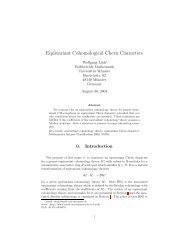Connes-Chern Character for Manifolds with Boundary and ETA ...
Connes-Chern Character for Manifolds with Boundary and ETA ...
Connes-Chern Character for Manifolds with Boundary and ETA ...
Create successful ePaper yourself
Turn your PDF publications into a flip-book with our unique Google optimized e-Paper software.
CONNES-CHERN CHARACTER AND <strong>ETA</strong> COCHAINS 69<br />
The essential property of the thus defined algebras of b-functions is that the coordinate<br />
system (x, η) : Y ◦3/2 → (−∞, ln 3/2) × ∂M induces an isomorphism<br />
(x, η) ∗ : b C ∞ ( (−∞, ln 3/2) × ∂M ) → C ∞( Y 3 2<br />
)<br />
, (A.6)<br />
which is defined by putting<br />
{<br />
(x, η) ∗ f :=<br />
(Y 3 f ( x(p), η(p) ) )<br />
, if p /∈ ∂M,<br />
2 ∋ p ↦→<br />
f0 − ,<br />
(η(p)), if p ∈ ∂M.<br />
<strong>for</strong> all f ∈ b C ( ∞ (−∞, ln 3/2)×∂M ) ( )<br />
. Under this isomorphism, b Ccpt<br />
∞ (−∞, 3/2)×∂M<br />
(<br />
is mapped onto Ccpt<br />
∞ 3 )<br />
Y 2 . In this article, we will use the isomorphism (x, η) ∗ to obtain<br />
essential in<strong>for</strong>mation about solutions of boundary value problems on M by trans<strong>for</strong>ming<br />
the problem to the cylinder over the boundary <strong>and</strong> then per<strong>for</strong>ming computations there<br />
<strong>with</strong> b-functions on the cylinder.<br />
The final class of b-functions used in this work is the algebra b S ( R × ∂M ) of<br />
exponentially fast decreasing functions or b-Schwartz test functions on the cylinder<br />
defined as the space of all smooth functions f ∈ C ∞( R × ∂M ) such that <strong>for</strong> all l, n ∈ N,<br />
D ∈ Diff(∂M) there exists a C l,D,n > 0 such that<br />
∣ ∂<br />
l<br />
x Df(x, p) ∣ ≤ Cl,D,N e −n|x| <strong>for</strong> all x ∈ R <strong>and</strong> p ∈ ∂M. (A.7)<br />
Obviously, (x, y) ∗ maps b S ( R × ∂M ) ( )<br />
∩ b Ccpt ∞ (−∞, ln 3/2) × ∂M onto the function<br />
space J ∞( ) (<br />
∂M, Y 3 3 )<br />
2 ∩ C<br />
∞<br />
cpt Y 2 .<br />
A.2. Global symbol calculus <strong>for</strong> pseudodifferential operators. In this section,<br />
we briefly recall the global symbol <strong>for</strong> pseudodifferential operators which was introduced<br />
by Widom in [Wid80] (see also [FuKe88, Pfl98]). We assume that (M 0 , g) is a<br />
Riemannian manifold (<strong>with</strong>out boundary), <strong>and</strong> that π E : E → M 0 <strong>and</strong> π F : F → M 0<br />
are smooth vector bundle carrying a Hermitian metric µ E resp. µ F . In later applications,<br />
M 0 will be the interior of a given manifold <strong>with</strong> boundary M.<br />
Recall that there exists an open neighborhood Ω 0 of the diagonal in M 0 × M 0 such<br />
that each two points p, q ∈ M 0 can be joined by a unique geodesic. Let α 0 be a cut-off<br />
function <strong>for</strong> Ω 0 which means a smooth map M 0 × M 0 → [0, 1] which has support in Ω 0<br />
<strong>and</strong> is equal to 1 on a neighborhood of the diagonal. These data give rise to the map<br />
{<br />
α 0 (p, q) exp −1<br />
p (q) if (p, q) ∈ Ω 0 ,<br />
Φ : M × M → T M, (p, q) ↦→<br />
(A.8)<br />
0 else,<br />
which is called a connection-induced linearization (cf. [FuKe88]). Next denote <strong>for</strong><br />
(p, q) ∈ Ω 0 by τp,q E : E p → E q the parallel transport in E along the geodesic joining p<br />
<strong>and</strong> q. This gives rise to the map<br />
{ (<br />
τ E α 0 πE (e), q ) τ E π<br />
: E × M → E, (e, q) ↦→<br />
E (e),q (e), if (π E(e), q) ∈ Ω 0 ,<br />
(A.9)<br />
0 else,<br />
which is called a connection-induced local transport on E. (cf. [FuKe88]).

















